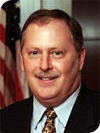Game On!

The fourth annual Fittest Execs and Fittest Companies Challenge is in the books, and the results have been deeply rewarding.
On a program level, the Fittest Execs and Fittest Companies Challenge recorded a record level of health improvements among those who completed final testing—83 percent of them tested out in December with higher health scores than when the competition started in September. You can read all about the winning teams and individuals in this edition of Ingram’s, but before you do, I’d like to share a few thoughts about the overall program.
Since its inception in 2009, the Fittest Execs Challenge has been able to redefine the concept of a workplace wellness program in the Kansas City area because of the work that our project partners have put into its comprehensive structure. That’s been made possible by the commitment to the Challenge from Blue Cross Blue Shield of Kansas City, the YMCA and University of Kansas Hospital, which provided guidance, support and assets to structure and conduct the testing. Other corporate sponsors, like Holmes Murphy and Associates, have put their money where their message is when it comes to improving health and fitness in the workplace.
No other competitive corporate health program of that I’m aware of assesses participants on 15 health indicators at the onset and completion of the event. We’ve seen corporate-sponsored weight-loss challenges, or highly publicized one-on-one competition between execs, and while those are admirable in their own ways, they don’t address the fundamental role played by executive leadership in changing corporate culture to foster a healthier work force.
A closer look at the dynamics of the Fittest Execs and Fittest Companies Challenge this year reflects exactly that. Last summer, I had a conversation with Joe Ratterman, chief executive officer for BATS Global Markets. It’s fair to say that a company that has performed at BATS’ level incorporates a fair amount of competitive zeal into its culture. He was more than eager to put some of that on display by entering a team in the Fittest Team category of the Challenge.
I suggested to him that if the competitive factor were really driving his decision, he might want to consider a separate team postured for Most Improved, since mixing individuals with different goals can dilute overall team results. He made a strategic decision to do just that—and both teams came away with first-place finishes. In addition to one team that tied with my Ingram’s team for Most Improved honors, Ratterman was part of another that claimed the Fittest Team title. And Ratterman himself posted the highest individual score in the field and the second-highest ever.
The bottom line: Executive leadership acted, the company made a commitment, it got behind its people, and it won.
That’s why we’d like to see more companies get in the game as well as come back to participate when we start the next Challenge this fall. We’ve seen some companies get on board, realize the benefits of the Challenge and then step back, but we’d like the next Challenge to be the most competitive, deepest contestant field in the history of the program. We’re certain that participation will not only yield a good experience, but a positive outcome, one that can drive individual results and a cultural change throughout an organization.
Ingram’s Magazine is a good example of that. We’ve fielded a team in each of the first four years, and this year, our team chasing Most Improved honors set a goal of 100 pounds of weight loss. We didn’t quite get there, but got damn close with a 95-pound collective drop in three months and it’s something we’re proud of.
When it became clear that we were within striking distance of our improvement goals, a couple of us grew a bit leery of what it might look like if the company organizing the Challenge ended up winning. Frankly, when I look at the outcomes, I think results matter more than appearances. Doggone it, we worked our tails off to get there, literally, and I’m proud of each member of our team.
On a personal note, I’ve been able to leverage the motivation for success into a lifestyle change that has been dramatic. In the three month competition, I lost 46 pounds, and 51 overall, including the week before the official start. I—we, on the Ingram’s team—still have a ways to go in terms of improvement, but I now have added incentive, and a track record of success, to compete next year not just for the Most Improved Man in my age group, but to register in the Top 10 Fittest Men category, as well.
I’d like to issue a challenge to you and your organization to get on board for what has proven through the test of time to be a program that will reward and inspire individuals, teams and company culture. The Fittest Execs and Fittest Companies Challenge will enable leadership to contribute to change the reality of Kansas City being known as one of the most unfit and overweight cities in the nation. I hope you enjoy the coverage and stories of all of this year’s winners in the pages that follow and remember just one thing: The first step is to Get in the Game!

Joe Sweeney
Editor-In-Chief & Publisher